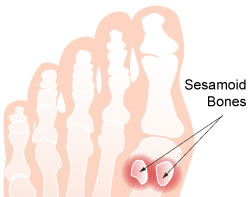Sesamoid
1. [noun] the sesamoid bones are tiny bones found with tendons that are located in the areas of the body where the tendons pass over joints. Their function is to assist the tendons mechanically, by holding the tendon further away from the joint to make movement easier, essentially as a fulcrum. They also provide a degree of protection for the tendons, helping it to achieve a more consistent pull. In contrast to cartilage in the joint which helps to cushion shocks and take the weight, sesamoid bones are purely involved with muscle activity. They can be found at various locations around the body, such as the knee, wrist, hand and foot with the later especially prone to injury . The location of the sesamoid bones in the foot is directly behind the joint of the big toe in the ball of the foot, where the two pea sized bones sit

Frequently Asked Questions
How do sesamoid bones in the foot differ in function from joint cartilage during movement?
Unlike joint cartilage that cushions impacts, sesamoid bones assist tendons by shifting their position, providing a mechanical advantage that makes toe movement smoother and more efficient.
Why does the term 'sesamoid' relate to these small bones in the foot?
The name 'sesamoid' comes from the resemblance to sesame seeds; these tiny bones support tendon function by acting as a fulcrum, optimizing the muscle pull at the big toe.
How can everyday walking or running illustrate the role of the sesamoid bones in the foot?
When pushing off during a walk or run, the sesamoid bones help guide the tendons in the big toe, enhancing leverage and ensuring smooth, efficient movement without directly bearing weight like cartilage.